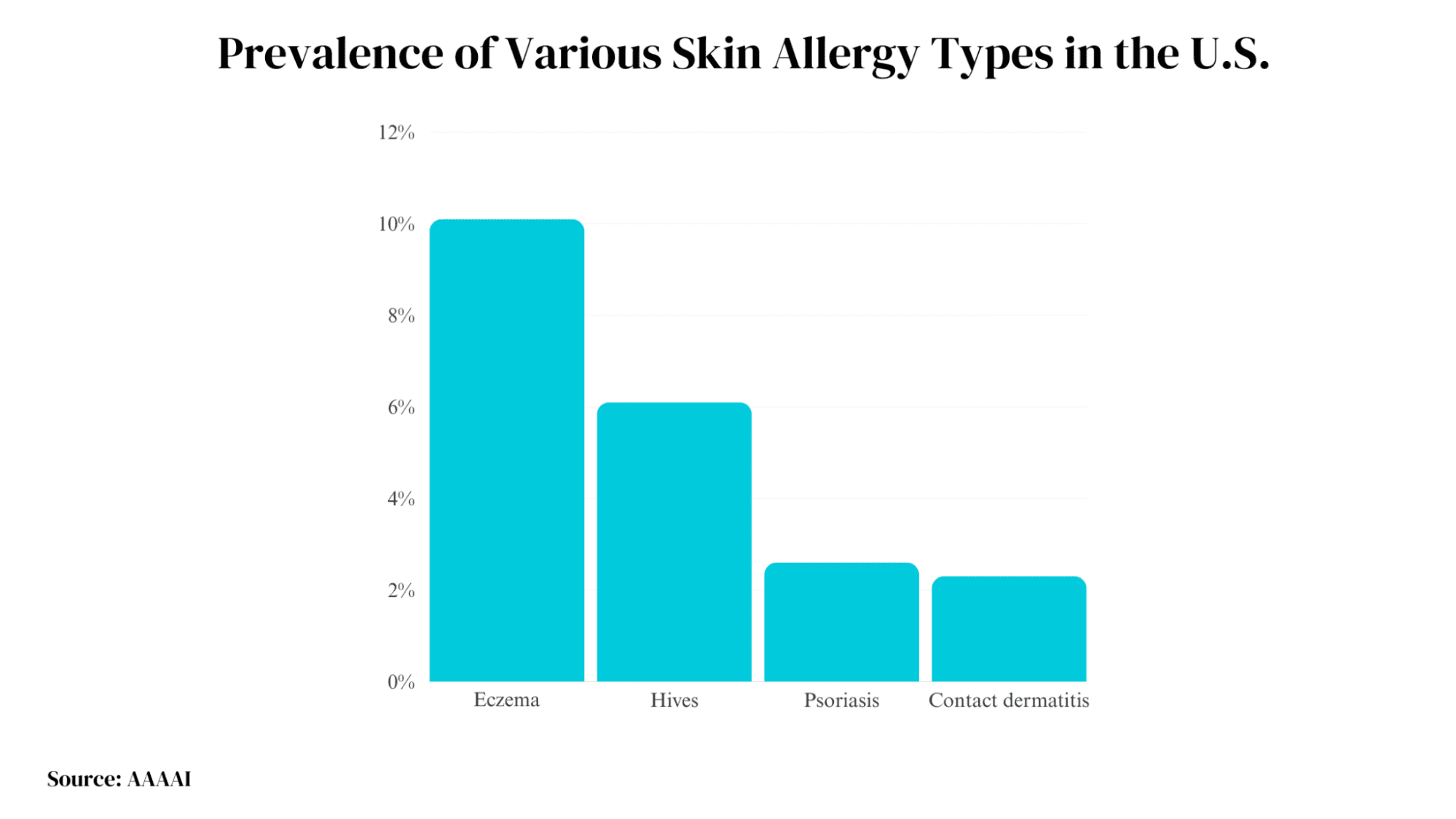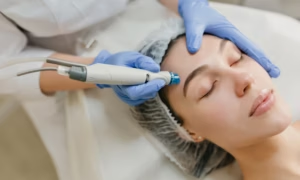Over 50 million people in the United States suffer from skin allergies and related conditions, including eczema and hives. These allergic conditions can severely impact the quality of life. Treating skin allergies is poised for a revolutionary transformation in the coming decade, thanks to the emergence of personalized biotechnology and digital health innovations.
Experts forecast the global skin allergy treatment market to grow from $3.7 billion in 2021 to over $8 billion by 2030. This rapid expansion will likely result from breakthrough technologies like nanoparticle delivery systems, immunotherapy, gene editing, AI-based diagnostics, and telehealth platforms.
Advancements in healthcare technology have the potential to enhance the care provided to individuals suffering from allergies
The Promise of Next-Generation Allergy Treatments
Antihistamines and steroid creams briefly lessen skin allergy symptoms but don’t provide long-term relief. In contrast, emerging biomedical therapies offer long-term solutions by addressing underlying immune dysfunction. Some key developments on the horizon include:
-
Nanoparticle Drug Carriers:
Tiny customized particles enclose medications and slowly release them at specific sites. This increases potency while limiting systemic side effects. Dendrimers, polymer-drug conjugates, solid-lipid nanoparticles, and other transports are being tested with allergy drugs.
-
mRNA Vaccines:
A technology that won the Nobel Prize has promise for treating allergies. It uses mRNA sequences to reprogram abnormal inflammatory responses by changing cell signaling cascades. These can induce durable immune tolerance specific to the allergy trigger.
-
Gene Editing Tools like CRISPR/Cas9:
These small scissors can alter allergy genes found in genetic testing by cutting DNA or changing epigenetic marks. This often curative approach is progressing rapidly.
-
Immunotherapies:
Allergy treatments slowly increase doses of allergens or use antibodies to train the immune system without side effects. Sublingual tablets, oral mucosal immunotherapy, and the advent of nanocarriers propel efficacy. Individuals facing severe skin allergies may seek guidance from a dermatologist specializing in skin allergies to assess the suitability of emerging immunotherapies. skin allergy doctor specializing in skin allergies to assess the suitability of emerging immunotherapies.
-
Probiotic Skin Creams:
Topical prebiotic and probiotic bacterial strains like vitamin B3-fortified Lactobacillus johnsonii help strengthen skin microbiome balance. This prevents dysbiosis that frequently enables inflammatory skin reactions to allergens and irritants.
Such innovations usher in an era of precision, causative allergy care for sustained remission. The government and industry partners are helping bring many affordable alternatives to the market. These alternatives are meant to replace current medications that have limited functionality.
The Role of AI and Digital Health
Artificial intelligence (AI) and telehealth solutions are modernizing the delivery of allergy care in tandem with technological advancements. Key implementations on the frontier include:
-
AI-assisted Rapid Diagnostics:
Machine learning pattern recognition of skin lesion morphology, rash distribution, and dermatoscopic features ensures accurate identification of triggers. Some mobile apps allow self-screening. Augmented intelligence is supplanting error-prone human analysis.
-
Digital Longitudinal Symptom Tracking:
Leveraging natural language processing and computer vision, virtual assistants allow patients to self-report symptom severity, treatment efficacy, and quality of life impact between office visits. This gives allergists visibility for optimizing care.
-
Video Telemedicine Consultations:
Telehealth expands access to specialized immune dermatologists for chronic urticaria and eczema management. Platforms enable image-supported video visits for evaluating reactions, advising avoidance, demonstrating skin treatments, etc. during flares. Store-and-forward images further facilitate remote diagnostics.
-
Smartphone Microscopes:
Compact microscopes that attach to phones improve self-tracking by helping patients capture and share high-resolution skin images remotely without office visits. Automated image analysis highlights warning signs.
-
Wearable Environmental Sensors:
Internet of Things gadgets like allergen exposure badges, and smartwatches tracking rashes or skin patches with vitals monitoring give insight into personalized triggers and responses for precision avoidance and treatment.
Integrating these technologies with innovative medications will likely dominate future care delivery. The global digital health market is anticipated to grow at a rate exceeding 15% annually, offering the promise of accessible and proactive allergy management.
Personalized Care for Better Outcomes
While novel options show promise for allergy sufferers, experts caution no singular treatment checklist applies universally. The future of effective skin allergy care lies in personalized precision medicine approaches.
Key facts of tailored allergy management align therapies to individual needs based the following on:
-
Pharmacogenetic risk profiling:
How will gene variants impact treatment metabolism or likely efficacy?
-
Longitudinal immune monitoring:
Are biomarker levels indicating appropriate response?
-
Environmental analysis:
Which airborne/food allergens or microbiome factors enable reactions?
-
Frequent effect measurement:
Is swelling, redness, or oozing resolving as expected over time?
This enables the prescription of emerging innovations tailored to specific patients based on data, ensuring optimal relief from suffering. State-of-the-art analytics thereby take the guesswork out of getting allergy relief.
“We now possess an unprecedented ability to analyze a person’s unique biology and environment to deliver bespoke solutions rather than Trial-and-error medication roulette. This is the future standard for expert allergy care.” – Dr. Alice Wu, Immunodermatology Fellow at Stanford School of Medicine
Comparison of Emerging Allergy Treatments
| Treatment | Mechanism | Benefits | Limitations |
| Nanoparticle drug carriers | Encapsulate active medication; controlled release at target sites |
|
|
| mRNA immunotherapy | Reprograms immune pathway signaling |
|
|
| Gene editing | Disrupts or silences allergy-related genes |
|
|
| Artificial intelligence | Automated pattern analysis for diagnosis and monitoring |
|
|
Overcoming Barriers to Adoption
While modern skin allergy treatments usher in an era of transformative potential, realizing mainstream access and acceptance faces obstacles that stakeholders must collaborate to overcome:
Affordability
- Emerging innovations often launch at premiums before economies of scale. Partnerships across payers, government, and developers to establish value-based pricing models can spur adoption.
Health Literacy
- Educating patients on the distinctions between innovative precision medicines and established treatment standards is crucial. This plays a pivotal role in setting appropriate expectations for their medical care. Clear awareness campaigns avoid confusion hindering uptake.
Regulatory Uncertainty
- Classifying sophisticated treatments into existing frameworks prolongs approvals. Regulators must adapt policies balancing innovation incentives and safety rigors.
Integration Complexity
- Linking advanced diagnostics, digitally-delivered prescriptions and pharmacogenetic data is key but technically daunting. Interoperability standards and EHR modernization can ease connections.
Clinical Inertia
- Overcoming provider’s tendency to stick to tried-and-true medications requires evidence-based guidance and overcoming outdated medical teaching.
By fostering a collaborative spirit among stakeholders to address these adoption barriers, the potential of emerging allergy care technology can become a reality for patients across the nation.
FAQs
What are the most common skin allergy triggers?
Nickel, fragrances, rubber additives, hair dyes, lanolin, neomycin, Balsam of Peru, formaldehyde releasers, poison ivy, and certain proteins are frequent skin allergy culprits. Patch testing accurately identifies unique reactions.
How can I minimize allergic reactions?
Avoiding identified triggers, using gentle hypoallergenic skin care products and laundry detergents, wearing gloves for irritant exposures, and maintaining skin moisture can help reduce contact dermatitis flares.
When should allergy sufferers consider emerging treatments?
Those with severe reactions uncontrolled by standard therapies may benefit from clinical trials of novel immunotherapies, genetically mediated solutions, or precision nano medications after thorough consultations regarding specific risks.
The Future Calls for Causal, Individualized Allergy Care
The skin allergy treatment landscape, from AI-assisted diagnosis to cure-focused biotechnology, exhibits significant innovation potential. As research continues affirming efficacy, increasing regulatory approvals and patient adoption will mark a tipping point towards modernized, accessible allergy care with an emphasis on underlying causes and unique needs.
This patient-centric approach, harnessing next-generation solutions, holds the promise of a future where constant itching, dependence on injections, and immunosuppression are no longer the prevailing norms but remnants of the past.




































